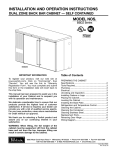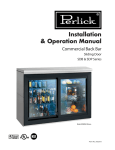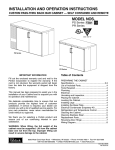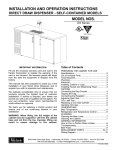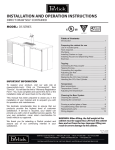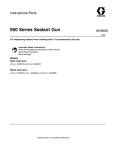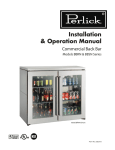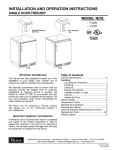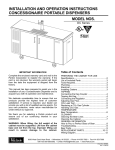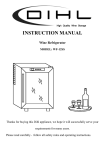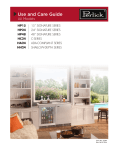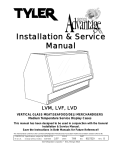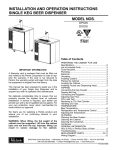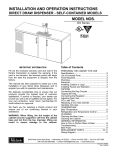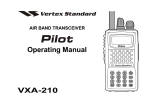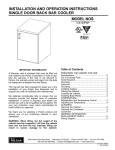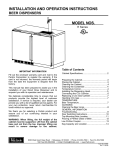Download Perlick CUSTOM NARROW DOOR BACK BAR CABINETS - SELF CONTAINED AND REMOTE NS Series User's Manual
Transcript
INSTALLATION AND OPERATION INSTRUCTIONS CUSTOMNARROWDOORBACKBARCABINETS–SELFCONTAINEDANDREMOTE moDELS NRSeries NSSeries NR40 NS52 NS72 NR60 ImPoRTANT INfoRmATIoN Toregisteryourproduct,visitourwebsiteat (www.perlick.com).Clickon“Commercial”,then“Service”. Youwillseethelinkto“WarrantyRegistrationForm”.You mustcompleteandsubmitthisformortheinstallation datewillrevertbacktotheshipdate. Thismanualhasbeenpreparedtoassistyouinthe installationofyourcabinetandtoacquaintyouwithits operationandmaintenance. Wededicateconsiderabletimetoensurethatour productsprovidethehighestlevelofcustomer satisfaction.Ifserviceisrequired,yourdealercanprovide youwithalistofqualifiedserviceagents.Foryourown protection,neverreturnmerchandiseforcreditwithout ourapproval. WethankyouforselectingaPerlickproductand assureyouofourcontinuinginterestinyour satisfaction. WARNING: When lifting, the full weight of the cabinet must be supported. Lift from the cabinet base and not from the top. Improper lifting can result in severe damage to the cabinet. Table of Contents PREPARINGTHECABINET ListofIncludedParts............................................................... 2 ToolsRequired............................................................................ 2 Plumbing...................................................................................... 2 Electrical....................................................................................... 2 UncratingandInspection...................................................... 2 PlacingtheCabinet.................................................................. 2 LevelingtheCabinet................................................................ 2 InstallingCastersorLegs....................................................... 2 InstallingtheBasePlates........................................................ 2 RefrigerationandTemperatureControl............................ 3 CleaningtheCabinet............................................................... 3 CleaningtheCondenser......................................................... 3 StainlessSteelCareGuide..................................................4/5 ReplacementParts.................................................................... 6 ReversingDoorSwing............................................................. 7 WiringDiagram(NSSeries)................................................... 8 WiringDiagram(NRSeries)................................................... 9 8300WestGoodHopeRoad•Milwaukee,WI53223•Phone414.353.7060•Fax414.353.7069 TollFree800.558.5592•[email protected]•www.perlick.com Systems and Products for the Food Service and Beverage Industries Since 1917 Form No. Z2285 Rev. 10.05.10 General Information – Narrow Door Back Bar Cabinets Parts List Placing the Cabinet • Push the cabinet into place using rollers when necessary. IMPORTANT: Proper air flow around the condensing unit is necessary for efficient operation. Never obstruct the air flow in and out of the condensing unit. For sanitation purposes, it may be necessary to seal the base of the cabinet to the floor. This can be accomplished by laying a bead of silicone sealant between the base of the cabinet and the floor as shown by the figure below: • • (3) Shelves per door (one may be used as a floor rack) Door lock keys Shelf clips Tools Required • • • #2 Phillips Screwdriver 3/8” Nut Driver Power Drill or Driver (for leg or caster installation) Plumbing Condensate from the cooling coil is automatically evaporated from the condensate pan located in the condensing unit housing. Each unit is also equipped with a floor drain located in the right rear corner of the cabinet. The drain can be plumbed to an external floor drain by connecting to the 3/4” NPT thread out the side or the 1” NPS thread out the bottom. Both drains ports come plugged from the factory and can be removed if needed. Leveling the Cabinet When the cabinet is in place, check installation with carpenter’s level. When level front to back and left to right, accumulated water will drain out of the cabinet. NOTE: Remote units require evaporator condensate to be plumbed to an external drain. Electrical The cabinet must be connected to a separately fused power source (see electrical specification plate) and grounded in accordance with National and Local Electrical Codes. Caution: Do not attempt to operate the equipment on any other power source than that listed on the Electrical Specification plate. Installing Casters or Legs (optional) Attach casters or legs to cabinet bottom in holes provided. Use the supplied 1/4”-20 x 3/4” hex head self-tapping machine screws. Installing Base Plates (optional) Attach brackets to cabinet bottom in holes provided. Attach base plate to brackets (see separate instructions, provided with kit). When returning cabinet to upright position, be careful not to bend brackets. Uncrating and Inspection Remove all crating material before operating. Carefully inspect cabinet for hidden damage. If damage is discovered, file your claim immediately with the transportation company. Perlick is not responsible for damage in transit. WARNING! To avoid compressor damage, after running cabinet in an upright position, let unit stand for 24 hours before plugging in and running the unit. Perlick is committed to continuous improvement. Therefore, we reserve the right to change specifications without prior notice Form No. Z2285 Rev. 10.05.10 2 General Information – Narrow Door Back Bar Cabinets Refrigeration and Temperature Control Cleaning the Cabinet Self-contained units are equipped with a heavy-duty refrigeration system that is factory set to maintain a product storage temperature of approximately 38° F. Use a mild detergent and water to clean the inside and outside of the cabinet. Dry thoroughly. Never use a scouring pad or abrasive cleanser. See the Stainless Steel care guide on pages 4 and 5 for more information on proper care of stainless steel. Adjusting the Temperature The temperature control is inside the cabinet on the left-hand side of the evaporator fan panel assembly. You will need a screwdriver to turn the adjusting screw. Make small adjustments until the desired temperature is achieved. NOTE: An industrial strength, commercial cleaner can be used to clean the outside of painted cabinets. Cleaning the Condenser The condenser (located behind the front grille cover) should be inspected every 30 days and cleaned, if necessary. Use a long handled, stiff brush or vacuum to clean the dirt from the front surface of the condenser. Keeping the condenser free from dust and dirt will ensure efficient operation. Colder Temperatures: Turn the adjusting screw clockwise (to the right) Warmer Temperatures: Turn the adjusting screw counterclockwise (to the left). Temperature Control ‘OFF’: Turn the adjusting screw completely counterclockwise to the ‘O’ position until a click is noted. CAUTION: Do not bend the fins while brushing the front of the condenser. The condenser fan motor turns off and on with the compressor. The evaporator fan motor is on all the time. Failure to keep the condenser clean will cause a loss in condensing unit efficiency. CAUTION: Cabinet temperatures lower than 34° F will not allow for proper defrosting of the evaporator coil. If defrosting is necessary, turn the control knob to the OFF position until coil is defrosted. Specifications For complete specifications, please visit our website at www.perlick.com. Perlick is committed to continuous improvement. Therefore, we reserve the right to change specifications without prior notice 3 Form No. Z2285 Rev. 10.05.10 STAINLESS STEEL CARE AND CLEANING REFERENCE GUIDE Contrary to popular belief, stainless steels ARE susceptible to rusting. Corrosion on metals is everywhere. It is recognized quickly on iron and steel as unsightly yellow/orange rust. Such metals are called “active” because they actively corrode in a natural environment when their atoms combine with oxygen. Stainless steels are “passive” metals because they contain other metals like chromium, nickel and manganese that stabilize the atoms. Chromium provides an invisible passive film that covers the steels surface acting as a shield against corrosion. As long as the film is intact and not contaminated, the metal is passive and stainless. If the passive film of stainless steel has been broken, equipment starts to corrode. At its end, it rusts. ENEMIES OF STAINLESS STEEL There are three basic things which can break down stainless steel’s passive layer and allow corrosion to occur: 1. Mechanical abrasion 2. Deposits and water 3. Chlorides Mechanical Abrasion refers to the things that will scratch a steel surface. Steel pads, wire brushes and scrapers are prime examples. Water comes out of the faucet in varying degrees of hardness. Depending on what part of the country you live in, you may have hard or soft water. Hard water may leave spots. When allowed to sit, these deposits will break down the passive layer and rust stainless steel. Other deposits from food preparation must be promptly removed with an appropriate cleaning agent. Chlorides are found nearly everywhere. They are in water, food and table salt. Household and industrial cleaners are the worst offenders. PREVENTING STAINLESS STEEL RUST Use the proper tools Use non-abrasive tools to clean stainless steel products. Soft cloths and plastic scouring pads will not harm the steel’s passive layer. Clean with polish lines Some stainless steels comes with visible polishing lines or “grain”. When visible lines are present, always scrub in a motion parallel to the lines. When the grain cannot be seen, play it safe and do not use a circular motion. Polish in a consistent straight pattern. Use alkaline, alkaline chlorinated or non-chloride containing cleaners While many traditional cleaners are loaded with chlorides, the industry is providing an ever-increasing choice on non-chloride cleaners. If you are not sure of chloride content in the cleaner being used, contact your cleaner supplier. If your present cleaner contains chlorides, ask your supplier if they have an alternative. Avoid cleaners containing quaternary salt; it also can attack stainless steel and cause pitting and rusting. Keep your food equipment clean Use alkaline, alkaline chlorinated or non-chloride cleaners at reccommended strength. Clean frequently to avoid build-up of hard, stubborn stains. The single most likely cause of damage is chlorides in the water. Remember, adding heat to cleaners that contain chlorides dramatically increases their caustic effect on stainless steel. Rinse, rinse, rinse! If chlorinated cleaners are used, immediately rinse and wipe equipment and supplies dry. The sooner you wipe off standing water, especially when it contains cleaning agents, the better. After wiping equipment down, allow it to air dry; oxygen helps maintain the stainless steel’s passive film. NEVER use hydrochloric acid (muriatic acid) on stainless steel! Perlick is committed to continuous improvement. Therefore, we reserve the right to change specifications without prior notice Form No. Z2285 Rev. 10.05.10 4 RECOMMENDED CLEANERS FOR SPECIFIC SITUATIONS Routine cleaning: Use soap, ammonia or detergent and water. Sponge the surface with a cloth, then rinse with clear water and wipe dry. Smears and fingerprints: Use Signature Cleaning Polish, Arcal 20, Lac-O-Nu, Lumin Wash, O’Cedar Cream Polish or Stainless Shine. Rub the surface with a cloth as directed on the package. Stubborn spots, stains and other light discolorations: Use Allchem Concentrated Cleaner Samae, Twinkle, Camaeo Copper Cleaners, Grade FFF Italian Pumice Whiting, Steel Bright, Lumin Cleaner, Zud, Restoro, Sta-Clean, Highlite Cooper’s Stainless Steel Cleaner or Revere Stainless Steel Cleaner. Apply with a damp sponge or cloth. Then rinse with clear water and wipe dry. Or... You can also use Household cleansers such as Old Dutch, Lighthouse, Sunbrite, Wyandotte, Bab-O, Gold Dust, Sapolio, Bon Ami or Comet. For these household cleansers, rub with a damp cloth. They may contain chlorine bleaches, so rinse thoroughly after use and wipe dry. Or... You can also use Liquid NuSteel or Dubois Temp. For these products, rub the surface with a dry cloth using only a small amount of cleanser. Rinse with water and dry. Heat tint or heavy discoloration: Use Penny-Brite, Copper Brite, Paste Nu-Steel, Dubois Temp or Tarnite and rub onto surface with a dry cloth. Or... You can also use Bar Keepers Friend, Revere Stainless Steel Cleaner, Allen Polish, Steel Bright, Wyandotte, Bab-O or Zud. For these cleansers, apply with a damp sponge or cloth, rinse thoroughly and wipe dry. Tenacious deposits, rust discoloration, industrial atomspheric stains: Use Oakite No. 33 Dilac, Texo NY, Flash-Klenz, Caddy Cleaner, Turco Scale 4368 or Permag 57. Swab and soak with a clean cloth. Let stand for 15 minutes or more according to directions on package. Then rinse and wipe dry. Rust discoloration or corrosion caused by cleaning agents containing hydrochloric (muriatic) acid or chlorine bleach: Use 3M Scotch Bright Pad, type A Grade “Fine”. Clean off the surface soil using cleaning methods above. Then rub discolored or corroded areas lightly with dry pad. Note: Use of proprietary names is intended to indicate a type of cleaner and does not constitute an endorsement. Omission of any proprietary cleaner does not imply its inadequacy. All products should be used in strict accordance with instructions on the package. Source: Packer Engineering, Naperville, IL (independent testing laboratory). REMEMBER... Use non-chlorinated cleaners with a soft cloth and rinse, rinse, rinse to maintain the natural qualities of your stainless steel equipment! Perlick is committed to continuous improvement. Therefore, we reserve the right to change specifications without prior notice 5 Form No. Z2285 Rev. 10.05.10 General Information – Narrow Door Back Bar Cabinets MODELS NS52 NR40 NS72 NR60 C22647 N/A C22646 N/A Condensing Unit 515301063 N/A 515301062 N/A Compressor 513200314 N/A 513200003 N/A Condensor Fan Motor Assembly 515315009 N/A 515315009 N/A Condenser Coil 15352019 N/A 15352019 N/A Terminal Board 519100088 N/A 519100088 N/A Condensing unit 115 volt, 60 hz. Overload Protector US-PB10HBX1 N/A US-PB12HBX1 N/A Relay US-PB10HBX1 N/A US-PB12HBX1 N/A Capacitor US-PB10HBX1 N/A US-PB12HBX1 N/A C17511-1EP C17511-1EP C17511-2EP C17511-2EP 65627-1,(2),(3) Evaporator Coil Evaporator Coil Assembly 65644-1 69197-1,(2),(3) 65644-2 Liquid & Suction Line 65084 N/A 65085 N/A Fan Blade 57699 57699 57699 57699 Evaporator Fan Motor C15239A C15239A C15239A C15239A Evaporator Fan Guard 65557 65557 65557 65557 Temperature Control 61283 N/A 61283 N/A Bulb Clamp C6634 N/A C6634 N/A Wire Harness, Compressor Bottom 65560 N/A 65560 N/A Wire Harness, Evaporator 65561 65561 65561 65561 Wire Harness, Light jumper 65538 65538 65539 65539 Wire Harness, Mullion Heater 65571 65571 65572 65572 Light Bulb 63821 63821 63821 63821 Light Bulb Guard 65525 65525 65525 65525 Light Socket 63484 63484 63484 63484 Light Switch 65535 65535 65535 65535 Lock 63762 63762 63762 63762 63761-1 63761-1 63761-1 63761-1 Lock Rail 65432-20SS or 65432-20 65432-20SS or 65432-20 65432-20SS or 65432-20 65432-20SS or 65432-20 Grille Rail 65432-12SS or 65432-12 N/A 65432-12SS or 65432-12 N/A 65565-1 N/A 65565-1 N/A 66215-1SS N/A 66215-1SS N/A Spacer, Lock Condensate Pan Condensing Housing End Panel Grille RG-NL2 N/A RG-NL2 N/A 65435-12SS N/A 65435-12SS N/A 65606L-1 or 65606R-1 65606L-1 65576-4L 65576-4L 66311-1 66311-1 65526-2 65526-2 Door Gasket 66237-5 66237-5 66237-5 Cabinet Hinge Group Left 66264L 66264L 66264L 66264L Cabinet Hinge Group Right 66264R 66264R 66264R 66264R Hinge Pin 63679-1 63679-1 63679-1 63679-1 66355 66355 66355 66355 N/A N/A 66356 66356 66398-1 66398-1 66398-1 66398-1 Condenser Housing Back Evaporator, Liquid & Suction Line Cover Evaporator Pan Door Handle Left or Right End Shelf - Flat Center Shelf - Flat Left or Right End Shelf Divided Center Shelf - Divded Plaster Strip Shelf Clips (bag of 12) *Replacement Door Several Options - Contact Factory 66237-5 N/A N/A 66399-1 66399-1 C19271-1 C19271-1 C19271-1 C19271-1 63019-3 63019-3 63019-3 63019-3 RND-NL2 RND-NL2 RND-NL2 RND-NL2 *Contact Perlick Milwaukee for complete door replacement. Cabinet serial no. required. Perlick is committed to continuous improvement. Therefore, we reserve the right to change specifications without prior notice Form No. Z2285 Rev. 10.05.10 6 reversing door hinge – Narrow Door Back Bar Cabinets Tools Required • • • STEP 8: Re-assemble hinge brackets to unit. Bottom right bracket is assembled as the top left bracket. Top right bracket is assembled as the bottom left bracket. #3 Phillips Screwdriver. 1/16” Allen Wrench. Flathead Screwdriver STEP 9: Right Hinged Door Re-insert top hinge pin. (as shipped from factory) STEP 10: Re-assemble lock rail from STEP #3 Handle Styles Bottom Hinge Bracket Top Hinge Bracket Operations to Perform on Door 65305-1 C31409-1 Not Reversible 65609-2 STEP 11: 65189 Remove bottom door hinge bracket from door assembly and remove door hinge bushing from bracket. Re-assemble door hinge bracket to previous position, without bushing. Operations to Perform on Cabinet STEP 1: Remove bottom hinge pin from assembly. STEP 2: Carefully lift and tilt out door assembly from the unit and set aside. STEP 12: Remove top door hinge bracket from door assembly and assemble door hinge bushing from STEP 11 to bracket. Re-assemble door hinge bracket to previous position with bushing attached. STEP 3: Remove lock rail from cabinet, requires removal of four screws. STEP 4: Remove top hinge pin. Remove top and bottom hinge brackets from the unit. STEP 13: Door with full length SS handle: There is no need to remove door handle. It will be positioned correctly when door is reversed. Remove these screws STEP 5: Remove hinge bushing from bottom hinge bracket and assemble to top hinge bracket. Bottom Hinge Bracket STEP 6: STEP 14: Taking care not to scratch the surface, remove hole plugs from the left hinge holes. STEP 7: Insert hole plugs into vacant right hinge holes. Door with SS pull tab or handle with wrap around bracket: Remove the two screws mounting the handle and reposition to appropriate location on the opposite side of the door. Remove lock retainer and install on opposite end of door. STEP 15: What was the door top is now the door bottom. Carefully lift the door onto the hinge brackets of the cabinet. The two hinge bushings should meet. Reinsert the bottom hinge pin to complete the door switching operation. Step #7 Step #6 Perlick is committed to continuous improvement. Therefore, we reserve the right to change specifications without prior notice 7 Form No. Z2285 Rev. 10.05.10 wiring diagram – NS Series Cabinets Perlick is committed to continuous improvement. Therefore, we reserve the right to change specifications without prior notice Form No. Z2285 Rev. 10.05.10 8 WIRING DIAGRAm–NRSeriesCabinets Perlick is committed to continuous improvement. Therefore, we reserve the right to change specifications without prior notice 9 Form No. Z2285 Rev. 10.05.10 Notes... Perlick is committed to continuous improvement. Therefore, we reserve the right to change specifications without prior notice Form No. Z2285 Rev. 10.05.10 10 Notes... Perlick is committed to continuous improvement. Therefore, we reserve the right to change specifications without prior notice 11 Form No. Z2285 Rev. 10.05.10 8300 West Good Hope Road Milwaukee, Wisconsin 53223 www.Perlick.com • 800.558.5592 systems and products for the foodservice and brewing industries since 1917













